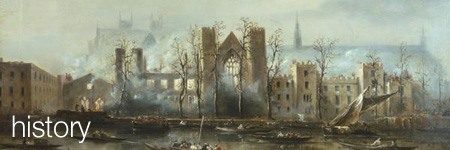
Fleet Street
City (EC4) Famous for journalists and newspapers, this street is named from the creek or stream of the Fleet, upon the eastern bank of which stood the Fleet Prison, abolished and removed in 1846, after nearly eight centuries' existence. (Reference: Timbs's Curiosities of London, p. 344) The Fleet Prison was a building presenting a long, gloomy, windowless wall. Founded at least as early as the reign of Richard I, it was a general court for debtors and such as were in contempt of the Courts of Chancery and Common Pleas. The Fleet Prison was also celebrated in the eighteenth century for its disgraceful marriages. Pennant, who spoke from personal knowledge, says: "In walking along the street in my youth, on the side next this prison, I have often been tempted by the question, 'Sir, will you be pleased to walk in and be married? ' Along this most lawless space was frequently hung up the sign of a male and female hand conjoined, with 'Marriages performed within' written beneath. Our great Chancellor, Lord Hardwicke, put these demons to flight, and saved thousands from the misery and disgrace which would be entailed by these extemporary thoughtless unions." (Reference: Smith's Streets of London, p. 282) There were certainly rough doings in Fleet Street in the Middle Ages, for the City Chronicles tell us of much blood spilt there and of many deeds of violence. The poet Chaucer is said to have beaten a saucy Franciscan friar in Fleet Street, and to have been fined 2 shillings for the offence by the Honourable Society of the Inner Temple. In old times Fleet Street was rendered picturesque, not only by its many gable-ended houses adorned with quaint carvings and plaster stamped in patterns, but also by the countless signs, bright with gilding and painted with strange devices, which hung above the shop fronts. (Reference: Thornbury's Old and New London, vol. I, p. 34)